Here, we will answer the biggest questions that curious people may be asking: what do baby bed bugs look like?
- This article has images of just born bed bugs – those that have fed on human blood appear reddish and those that haven’t are whitish (as shown illustrated in the pictures).
- You will also find information on their bites.
Those in the image below are one week old but newly hatched babies are even tinier.
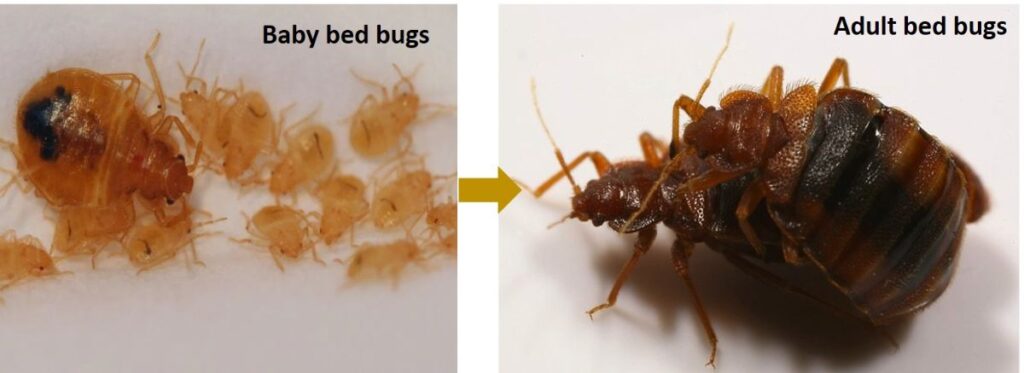
How do you identify them?
Baby bed bugs (also known as nymphs) are tiny, translucent, or sometimes whitish-yellow insects that hatch out of bed bug eggs. Without a blood meal, baby bed bugs are almost invisible to the human eye due to their small size and color.
You can identify baby bed bugs through the following:
- Color
- Size
- Smell/odor
- feeding behavior (bite a lot and itchy)
Below is a baby bed bug on a finger. They are usually so tiny, many of them can fit on your nail.

| Color | Milky white, translucent, reddish-brown |
| Size | 0.7 – 1 mm |
| Smell | No smell in Phase 1 development |
| Feeding | Bites a lot/itchy |
| Speed | Underdeveloped legs, slow movement |
After feeding, the young bed bugs will usually look slightly different from their appearance immediately after hatching.
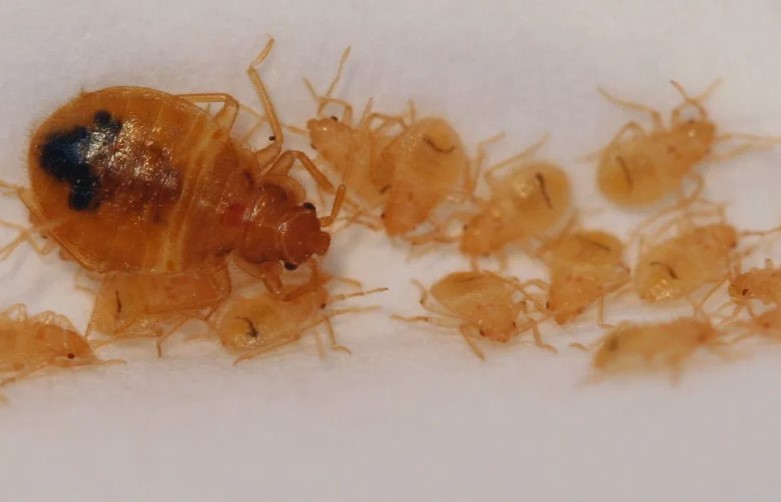
The color of young bed bugs is usually similar to that of bed bug eggs. This is often described as milky white, translucent or reddish-yellow depending on how much blood it has consumed.
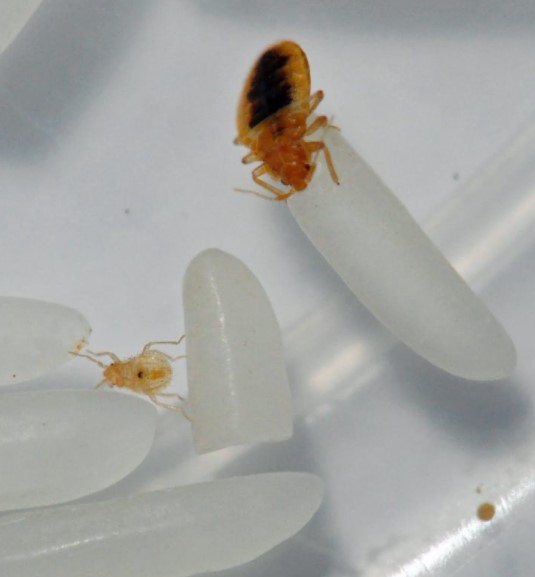
The image of baby bed bugs below show young ones that has just fed successfully for the first time after hatching.

Just Born Baby Bed Bugs
Just born baby bed bugs are quite tiny, measuring just about 1 mm. They are recently hatched and look like their adult counterparts. Immediately after hatching, tiny newly born bed bugs have developed legs and can walk around.
Since they do not undergo metamorphosis, just born baby bed bugs do not look like worms during their early stage development.

They are quite difficult to see with the naked eye, unless someone spends a good amount of time scrutinizing beddings.
Read: What do adult Bed Bugs look like?
However, the young bugs could give away signs such as droppings after sucking blood. Even though you may not spot them soon enough, their droppings usually sell them off allowing you to start termination.
Size of Baby Bed Bugs
How big are baby bed bugs?

The 1st and 2nd are always classified as baby bed bugs.
These five stages will take about 37 days.
According to EPA, bed bug sizes range from 1mm to 5 mm wide and 1.2mm to 7 mm long. Female bed bugs tend to be larger than males.
So, apart from their color, you can also identify bed bugs using their sizes. Baby bed bugs are smaller compared to adult ones. This difference varies significantly depending on the feeding levels.
The average size of bed bug eggs is 1 mm. That means the newly hatched bugs will not be extremely smaller than the eggshells.
A good comparison of that of a grain of rice.
Spotting the young ones may prove to be a mountain to climb, especially due to their milky white color.
Stages of development
First stage: In the first stage of development, a baby bed bug measures approximately 1-1.55 mm.
Stage 2: The second stage of development is associated with significant changes in size and color as the bugs have fed and begun molting.
These young pests will still be about 3 times smaller than adult bugs.
Their growth after this initial phase is known to be 0.4-0.5 mm in each phase. Multiplied by 5 stages, a 1.55 mm newborn bed bug growing at 0.5mm/per stage will be slightly larger than 4mm. This is the average size of an adult bug according to EPA.
In this image, you can see several egg casings and young bed bugs.
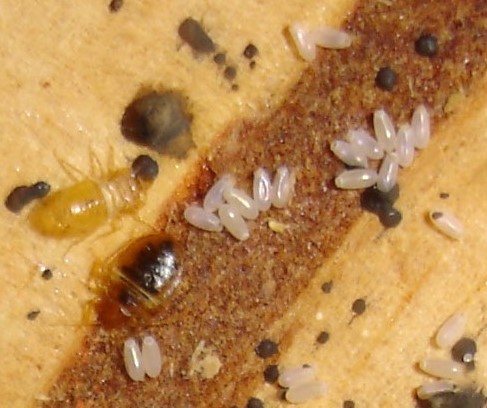
There is also a baby bed bug that has had a blood meal while the other on the left is not yet fed.
From this image, we can tell that baby bed bugs are usually whitish.
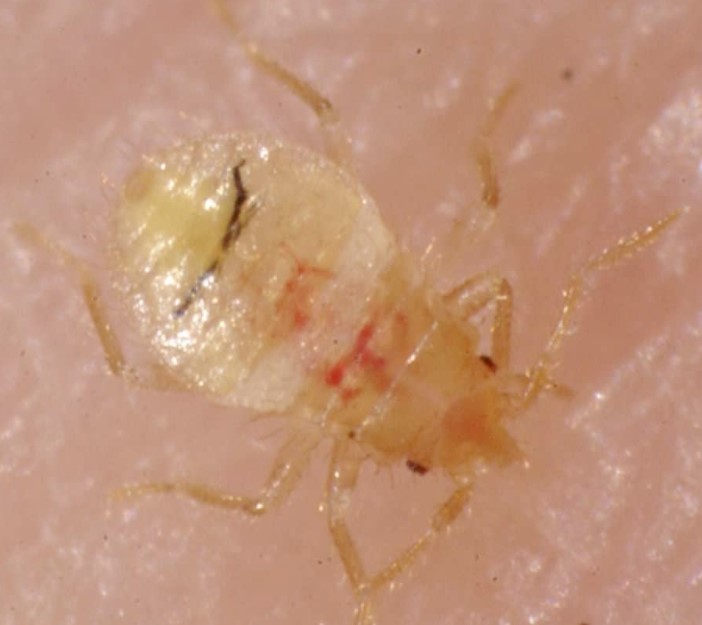
Due to their translucent body, if they haven’t had some blood meal, they may be difficult to spot.

Having a white bed sheet, pillow, blanket, or mattress cover makes it even tougher to spot them.
One important thing…
A baby bed bug will go through 5 stages before eventually becoming an adult. During those stages, the color gets darker.
First, they get a blood meal, digest it, and undergo the initial molding (shedding of the exoskeleton).
At about 2-3 weeks, young bed bugs move into the next stage of development.
Usually, they need to feed at least 5 times before maturing.
After the first meal, they start to turn brown, and the older the bed bug gets, with proper feeding, the darker it becomes.
By the end of the fifth stage of growth, a bed bug will look like this…
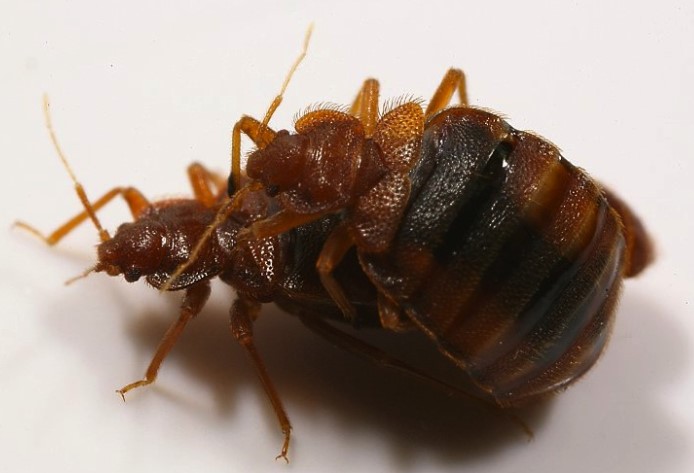
The insects are entirely brown due to the nutrients they have derived from blood meals.
Baby bed bugs come from these white bed bug eggs
In general, baby bed bugs are smaller and underfed versions of adult ones.
A full-grown bed bug will be about 0.25 inches to 0.4 inches long. However, the nymphs are not easy to notice because they are much smaller than those sizes.
Their color is less obvious. Rather than the usual reddish-brown color that we see in adult ones, the younger ones look almost similar to their egg casings.
Where do young bed bugs come from? Young bed bugs are hatched from eggs laid by female bed bugs. An adult female bed bug can lay up to 250 eggs in her lifetime.
If you have one female pest in your house, it can lay those eggs that will hatch only after about 6-10 days. After that, the infestation will begin to grow exponentially as new ones lay more eggs that hatch and grow.
Where can you find young bed bugs?
You can locate young bed bugs in the following places:
- Cracks and crevices where adults lay eggs.
- Places where human hosts spend the most time (bed, couch)
- Mattresses
- Bedroom seats
- Headboards
- Curtains
- Electrical items and outlets
Baby Bed Bug Bites
Baby bed bug bites feel the same as adult bed bug bites. It is itchy and the spot may develop a tiny red bump.
Baby bed bug bites are often itchy, just like adult bites. The reason for this is because young bed bug bites leave saliva which contain histamines that causes a burning sensation that could last a couple of days.
The image below are bites from two young bed bugs.
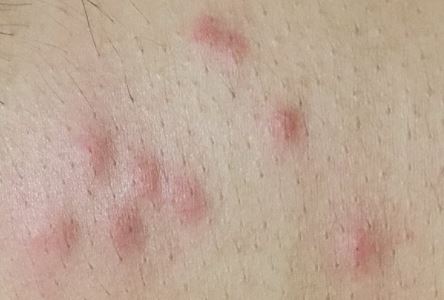
However, not everybody will feel the itching from the bites because they may not be allergic to bed bug saliva.
- The bites will appear in small groupings in a straight line.
- Sometimes, they look like raised, itchy red welts.
The young ones and adult ones bite using straw-like antennae located at the tip of their head. They have two of these structures for biting.
First antennae is used to inject the bug saliva. The fluid contains an anesthetic that will numb the biting spot.
The second antennae is used for sucking blood from the host.
Are bites dangerous?
No, bed bug bites are not dangerous. Scientists identified that bed bugs never carry diseases. Their bites do not cause or spread any serious disease except the itchiness, swelling, and possible scarring when one scratches the spot.
When you have a serious allergic reaction, consider seeking medical assistance immediately.
Will the bites go away?
Yes, bed bug bites will go away without any treatment and this occurs within 2 weeks… at least for most people.
This picture shows a baby bed bug that has just started feeding. Its exoskeleton is transparent and the blood can be seen inside its stomach.
Does baby bed bug bite itch?
The bite can be itchy since baby bed bugs also produce histamine that reacts with the body. Histamine is the insects’ pheromone for communication, especially when disturbed.
Any person who is not allergic to the saliva will often never notice they’re being bitten. Some people can never sleep after a single bite because they react so much and the itchiness never goes away fast enough.
How long will the baby bed bug feeding last?
An adult will require about 5-10 minutes. A baby bed bug feeding duration is much shorter since they do not need too much to fill up. Some of them will be full in just over one minute.
However, there may be swelling since the body detects a foreign substance that it reacts to. The site becomes red as more blood cells rush to the place to fight the intrusion.
Baby bed bug odor
Do baby bed bugs smell? Baby bed bugs that have not had a blood meal and are transparent do not have a distinct smell like mature bed bugs.
These baby bed bugs are troublesome because of the following:
- They need to feed frequently and begin searching for food immediately after hatching.
- They are extremely difficult to spot.
- They bite just like the adult ones.
When their bites get itchy, you might think that you’re having a skin problem because you may not know where exactly they are.
What’s more to know?
- Female bed bugs lay about 1-7 eggs every single day and this goes on for 10 days after they’ve had just 1 blood meal.
- The ratio of male to female eggs always tends to be 1:1 for an infested area.
- A female bed bug wandering around the house can lay its eggs anywhere in the room. They don’t care.
- About 97% of eggs hatch successfully if they are not exposed to harsh conditions. That is a high hatching rate.
Did you know?
The population of bed bugs will double every 2 weeks if the laying conditions are normal for female bugs (temperatures between 70 and 900 F).
Instar
Instar is the phase between one molting period and another in the development of an insect such as a bed bug.
When baby bed bugs do not get food
They stay in one instar for longer and may not molt to the next stage until they find a blood meal. Some will die because newly hatched nymphs are weak and cannot crawl distant surfaces to find their host.
Dehydration usually causes death of a nymph if it cannot locate a host.
I found one baby bed bug, what does it mean?
This should be an alarm. Immediately take action. It’s probably too late and to stop a heavy infestation, your home will require a full-scale bed bug treatment.
Baby bed bugs run fast
Yes, young bed bugs run fast but not as adults. The nymph exoskeleton is underdeveloped and their six legs are short. So, they may not crawl faster than other bugs. However, they are tiny and can easily disappear in their harborages.
How to get rid of baby bed bugs
To get rid of baby bed bugs, initiate a full fumigation process because spotting one could be a sign of infestation that has been ongoing. Young bed bugs can be eradicated from one location if they just recently hatched and have not crawled to different places. Here are the steps for getting rid of baby bed bugs:
- Locate the crevice or place where they hatched.
- Heat water to boiling and pour it over the bed bugs. Most bed bugs and their eggs will die at temperatures above 50 degrees Celsius.
- If the insects hatched inside items such as electronics, do not use hot water.
Heat treatment is usually recommended because it is safe and cheap.

